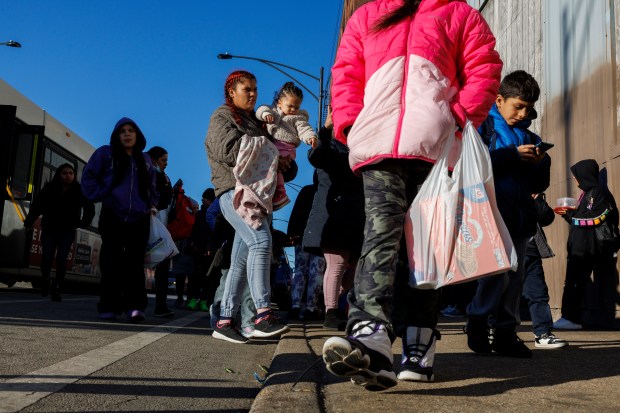Migrants across the city are leaving shelters in droves, their belongings stuffed in trash bags they load into Ubers or Lyfts, which they’ve often arranged themselves to head to new homes.
More than eight months after state and city leaders said they wanted to help thousands of migrants find homes in Chicago, the government assistance program covering their initial months of rent is moving faster than ever.
Migrants are now mostly settling on the South and West sides, where they say rent is more affordable with the approximate $1,500-a-month rental assistance they say they receive from the state. Working in partnership with the city, nonprofit organizations in Chicago and case managers from Catholic Charities of the Archdiocese of Chicago, the state has spent $41.4 million so far to resettle more than 5,000 households, according to the Illinois Department of Human Services.
In the past month, the number of migrants residing in city shelters has decreased dramatically due to a combination of migrants leaving the city to connect with family and friends in other cities and states and a change to the rental assistance program that allows migrants to find their own apartments without the assistance of a case manager, according to officials.
“There were good things and bad things about the shelter,” said Angelica Beltran, 44, from Maracaibo, Venezuela who has settled in Englewood. “But I didn’t want to stay.”
Officials are trying to scale back the number of migrants living in the nearly two dozen makeshift shelters in abandoned buildings, in turn easing the financial burden for the city and state of caring for migrants.
But as the number of migrants in the city’s remaining 23 shelters has shrunk to approximately 12,000 — down from a peak of more than 15,000 in 27 city-run shelters in mid-December — some migrant advocates are questioning whether the rapid resettlement plan is in the best interest of asylum-seekers.
Meanwhile, community leaders and advocates wonder about the long-term effect it will have on the neighborhoods they are moving into.
In a city of more than 2.6 million, routinely considered among the most segregated in the country, the resettled migrants are finding themselves isolated, untethered from a support system with familial and cultural ties. Unlike waves of immigrants before them, there is no established community for the mostly Venezuelan migrants to settle.
How the process of integration into neighborhoods will work is anyone’s guess, said Sylvia Puente, president and CEO of the Latino Policy Forum.
“I don’t think anyone can predict the future, but I know that it’s definitely going to be challenging,” she said.
While most migrants say they are grateful for the help moving out of the cramped living conditions at shelters, they face new challenges in their new homes: unheated and unfurnished apartments, hostility from neighbors, unfamiliar and sometimes dangerous surroundings, and an uncertain future.
Franzo Lira, 42, from Caracas, Venezuela, sat on an upside-down bucket in his living room in Auburn Gresham on a recent Sunday.
He said he had been staying at his apartment with sparse furniture since late December. His wife and two daughters made the trip to the United States after he did, but they ended up in Phoenix. He was saving up money to buy them airplane tickets to come to Chicago.
“I’m working every day,” he said. “But I don’t have the money to buy furniture.”
Officials say shutting down shelters is cost-effective. State, county and city officials project $321 million is needed to keep the migrant operation afloat through the end of 2024. The five shelters that have closed down since Feb. 9 will save the city at least $19 million, city spokesperson Mary May told the Tribune in a statement.
A few months ago, resettlement paid for by the state was more thorough but slower. Families received six months of rental assistance, full furnishings and help from a case manager. But as of Nov. 17, that aid was cut off. Most migrants in shelters were told then they would only receive three months of rental assistance, and those who arrived after mid-November didn’t qualify for rental assistance at all.
In mid-January, migrants began to resettle through what Mayor Brandon Johnson’s deputy chief of staff Cristina Pacione-Zayas called a “fast track.” This means migrants can find an apartment without a case manager — who would typically help them find a good location in the city to settle and provide basic information about how to pay bills and plug-in utilities and gas.
Pacione-Zayas said city officials have no plan to assist migrants in their new neighborhoods. A state spokesperson said once migrants move into units of their own, they are connected to other community-based organizations, such as Illinois Welcoming Centers, who can help make connections with additional services, as needed.
But advocates who work with migrants on the ground are concerned about the city’s strategy.
“It’s a logistical problem without a real logistical solution,” said Annie Gomberg, a lead volunteer helping migrants.
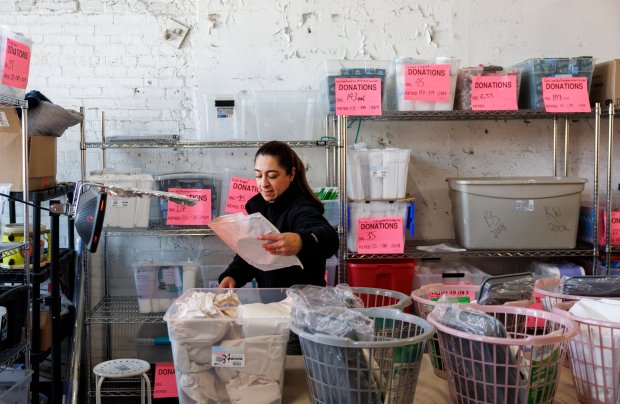
Every day, migrants bring their suitcases to empty houses in neighborhoods around Chicago they can’t pronounce. They arrive with their personal belongings and the pillows and blankets they’ve accumulated at the shelter.
New Life Centers is a nonprofit in Little Village helping to ease the moving process. It provides furniture for as many as 55 households of asylum-seekers a day, said Connie Marquez, director of inventory and warehouse. Migrants receive bed frames and a welcome basket with towels, dish soap, plates, toothpaste and toothbrushes.
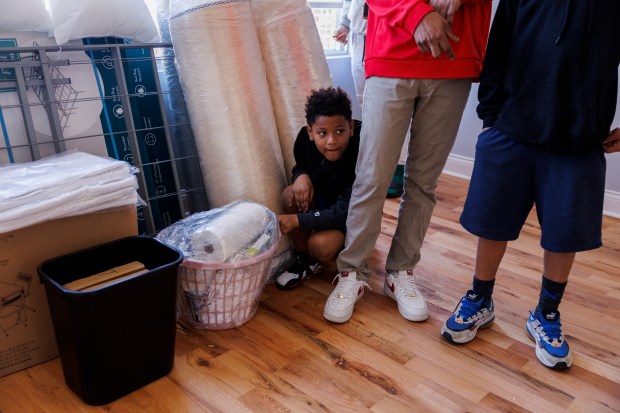
The organization has provided furniture for more than 13,000 people in over 3,000 apartments, according to data provided to the Tribune.
“We can’t do it fast enough. There’s such a huge need,” Marquez said.
Because of the fast-tracked resettlement process, some migrants don’t know how to plug in their utilities and experience a delay in getting their furniture, according to Jennifer Torres, a volunteer with Refugee Community Connection. She said she has received a flood of requests over the past few weeks from families who needed more assistance.
“If they don’t know a volunteer, they’re just floating. They don’t know what to do,” she said.
Andre Gordillo, director of the New Vecinos Program at New Life Centers said migrants choose whatever housing option they can find that is the least expensive and readily available. Migrants are desperate to get out of shelters, Gordillo said, so they will sign leases quickly.
“They don’t want to be in the shelter,” he said. “But they might not know exactly where they’re moving into and the dynamics of the neighborhood.”
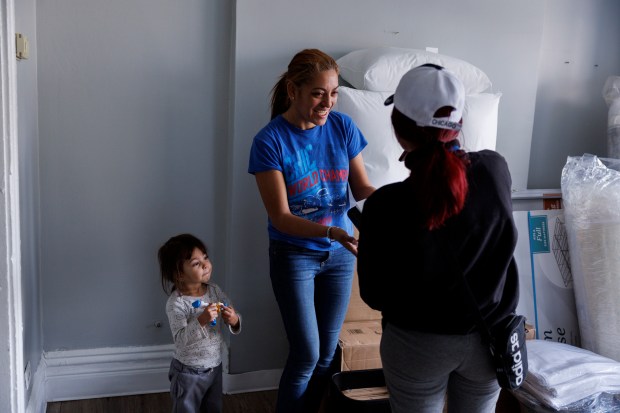
Iris Britit, 39, said she had been sleeping on the floor of the gym at a shelter in the West Loop before moving.
She had spent a month touring apartments before she found one in North Lawndale that would accept her application. Her 2-year-old twins hugged her legs as she stood in her new home.
“We were looking every day,” she said. “Calling and calling and nothing.”
Britit worked in retail in Barquisimeto, Venezuela, and her husband worked at a bakery. The bakery shut down due to economic instability, she said.
She said her husband now works at Walmart. The apartment is $1,600 a month, and Britit eventually also wants to work to meet rental payments.
Last week, two movers for New Life Centers brought mattresses up the stairs of Britit’s home. Her daughter Aliss wore pajamas and played with a plastic figurine while Milena Gallego, a New Life Centers mover, went through the inventory of furniture.
“Say ‘Chicago!’” Gallego said as Britit and her daughter posed for a photo in front of the new items wrapped in plastic.
Britit didn’t know anything about her new neighborhood, but said she loved Chicago.
“I really like it here. It’s all beautiful. The houses. All of it,” she said. “We’ll make it. Little by little. Poco a poco.”
But while a new apartment might represent full of promise for some, others have encountered hostility — and even violence in their new living situations.
Earlier this month, a mass shooting in Little Village left six migrants injured, said Matt DeMateo, pastor and executive director at New Life Centers. The dispute happened in front of a home that migrants had moved into last summer.
DeMateo said his staff worked to move the migrants into hotels and provide them with food. He said none of the injured migrants had died.
DeMateo, who has worked in violence prevention in Little Village for years, said violence against migrants so far hasn’t been a massive issue, though there have been a few concerning incidents.
“Some of them are wrong place wrong time, some of them are not understanding the dynamics of the streets, some of them are road rage incidents gone bad … and then some of it is just random acts of violence which they’re caught up in,” he said.
Several of the migrants who were shot in Little Village had children already settled in school, DeMateo said. Five family units were affected, he said, and those living in Little Village don’t want to move back to the neighborhood.
New Life Centers has organized six welcome events for migrants in different neighborhoods on the South and West sides. They try to introduce migrants to core churches and nonprofits in their communities.
“How do they get connected? How do they know what’s there? How do we walk with them?” DeMateo asked.
Two days after the Feb. 11 shooting, Maritza Canales, 68, who was working in a corner store nearby, said she didn’t know exactly what had happened, but that there had been tensions between Venezuelans and Mexicans in the neighborhood.
“It is embarrassing to us. All Latinos now face racism as a result of the Venezuelans,” she said.
She laments the fact that migrants are receiving help to get work permits, while some in the Latino community who have lived there for decades are being ignored.
Social workers helping the migrants involved in the shooting said it can be hard to know how to maneuver around the streets in Little Village. Migrants don’t know what to wear to avoid being targeted by gangs.
Beltran, of Venezula, is staying in a bare two-bedroom apartment in Englewood with her husband, 8-year-old son and four other family members.
Like hundreds of others, she said she found the apartment through the “vía rapida” or “fast-track.” Once she heard it was an option to leave without a case manager, she found a housing option as fast as she could.
A family of Venezuelans from Caracas — or “Caraceños” as Beltran calls them — lives in the apartment above, but Beltran said she still feels out of place in their neighborhood. They have barely left their house since they’ve arrived except to get food, she said.
Their relative, Angel Pírela, was kidnapped in Mexico for 12 days on his way to the United States, she said. He arrived in Chicago in early February and now sleeps in the kitchen on a single bed with a headboard made out of cardboard. His commute to work at a kitchen in Chinatown is over two hours.
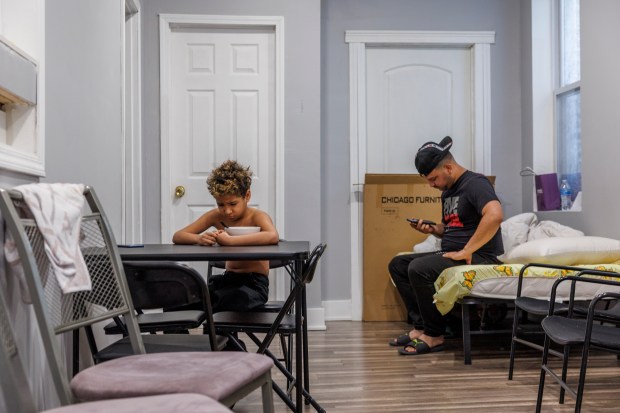
“Walking in the back door at midnight can be terrifying for him,” said Beltran.
Katherine Shank, chief executive officer and executive director of Legal Aid Chicago said migrants who don’t qualify for rental assistance, like Pírela, may become part of the “hidden homeless,” or those who don’t have stable housing and opt to sleep on the floors or couches of families and friends.
“Rental support is going to expire, and so when that happens it’s very easy to predict there will be an increase in evictions,” she said.
According to data provided by the Chicago Coalition for the Homeless, there were 22,777 students in temporary living situations enrolled in public schools at the end of January — a 57% increase from the previous January and more than ever recorded.
Alyssa Phillips, the organization’s education attorney said having the appropriate resources to support students in temporary living situations has always been a concern for Chicago Public Schools. She said the thousands of migrant students who have enrolled in CPS schools around the city greatly exacerbate this need.
“We’re advocating for funding so that schools have the resources they need to adequately and appropriately support (migrant) students,” she said.
The elementary school where Beltran’s 8-year-old son Engerberth had been going was hours from their new home in Englewood. Beltran decided to register him at Wentworth Elementary, just a few blocks from their new apartment.
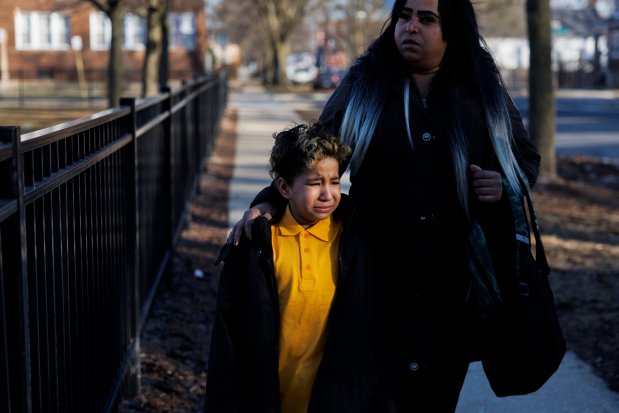
“But there is hardly anyone there who speaks Spanish,” she said. “He doesn’t want to go.”
Outside his new school in Englewood at the beginning of last week, Engerberth held onto the railing of the stairs outside so he wouldn’t have to enter. Beltran grabbed his jacket and he shrugged her off, snot dripping from his nose.
“I don’t want to go. I don’t want to go,” he repeated.
Beltran pulled him inside, but he was so miserable she and her husband decided to take him home. As they walked back to their apartment, Beltran said she hoped to move again after her state rental assistance ran out, but she didn’t know where she would go.
A security guard working at the school’s welcome desk watched the family leave.
“He’s just not ready,” the woman said.


